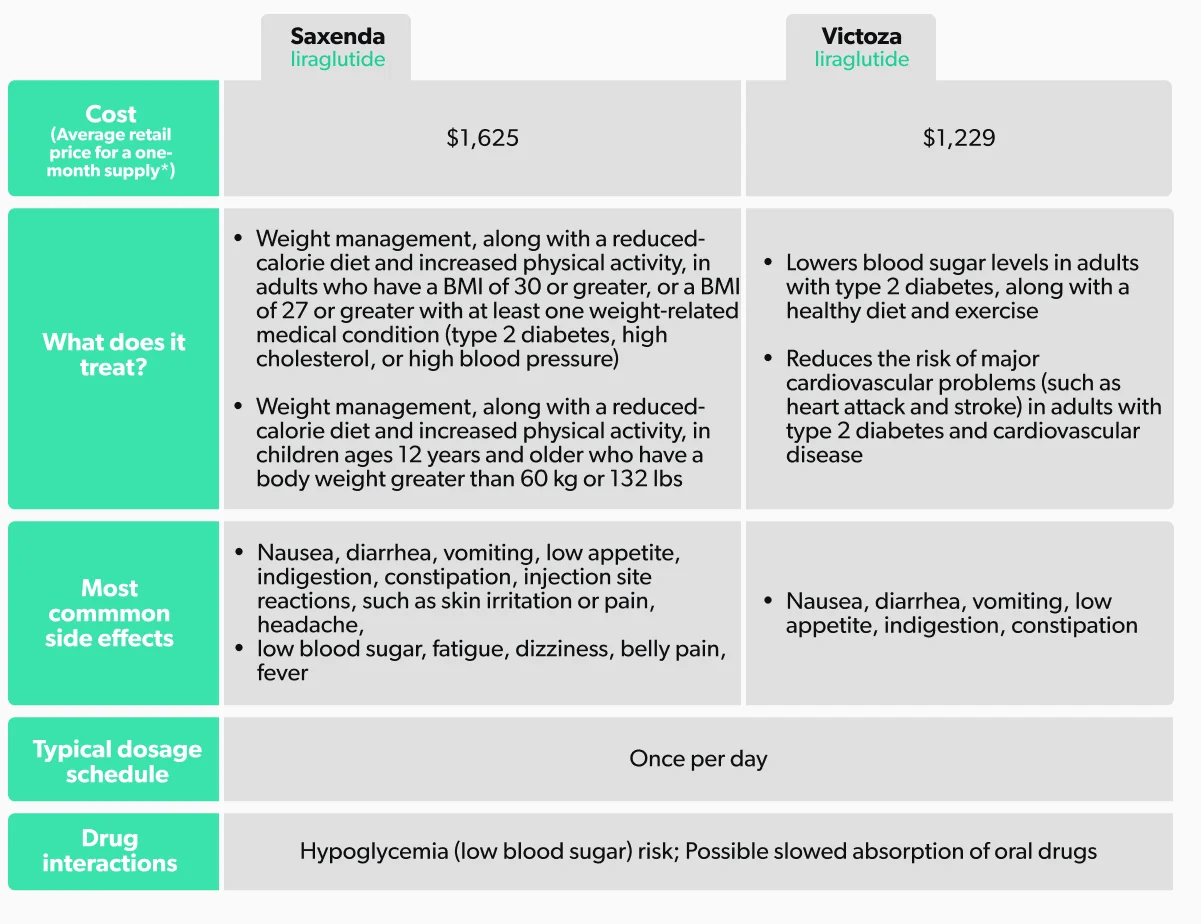Here's what we'll cover
Here's what we'll cover
When it comes to making healthy weight goals, looking into all the different options for diets, fitness programs, and supplements can be overwhelming. A good starting place, especially if you have medical conditions such as type 2 diabetes, is talking with a healthcare provider.
Some people may benefit from taking medication like Saxenda or Victoza. They both contain the same active ingredient, liraglutide, which can help people maintain a healthy weight and improve control of their blood sugar levels. Let’s take a closer look at the similarities and differences between Saxenda and Victoza.
What are Saxenda and Victoza?
Saxenda and Victoza are brand-name prescription drugs. They both contain the same active ingredient: liraglutide. Liraglutide, which belongs to a drug class called glucagon-like peptide-1 (GLP-1) receptor agonists, works to lower blood sugar levels and promote weight loss (Collins, 2021).
While Saxenda and Victoza contain the same active ingredient, the Food and Drug Administration approves them for different uses (also known as “indications”). You should not use them together or with other GLP-1 receptor agonists like exenatide (Byetta, Bydureon), semaglutide (Ozempic; Rybelsus), or dulaglutide (Trulicity).
Ozempic Important Safety Information: Read more about serious warnings and safety info.
What is Saxenda?
Saxenda (liraglutide) is a brand-name drug that healthcare providers prescribe to help with weight loss. It comes as a clear liquid solution in an injection pen. After a healthcare professional shows you how to use Saxenda, you’ll give yourself a daily injection under your skin (a subcutaneous injection). Before each dose, you’ll need to attach a new pen needle, which is sold or dispensed separately.
Saxenda comes in boxes of three or five pens. The number of doses of Saxenda per pen depends on the dosage that your doctor prescribes. The usual starting dosage is 0.6 mg per day. Your healthcare provider may increase your dose each week, depending on how well you tolerate the medication. Typically, the goal is to eventually reach the maximum dose of 3 mg per day (FDA-a, 2020).
What is Victoza?
Victoza (liraglutide) is a brand-name drug that healthcare providers prescribe to people with type 2 diabetes, especially when other diabetes medications like metformin aren’t helping enough.
Victoza comes as a clear liquid solution in an injection pen. After a healthcare professional shows you how to use Victoza, you’ll give yourself a daily injection under your skin (a subcutaneous injection). Before each dose, you’ll need to attach a new pen needle (sold or dispensed separately).
Victoza comes in boxes of two or three pens. The number of doses per pen depends on your dosage. Each Victoza pen contains 30 doses of 0.6 mg, 15 doses of 1.2 mg, or 10 doses of 1.8 mg.
Conditions treated with Saxenda and Victoza
So, what do Saxenda and Victoza treat? Here is a look at their uses and when healthcare providers may prescribe each.
Saxenda uses
Healthcare providers may prescribe Saxenda for weight management, along with a reduced-calorie diet and increased physical activity, to the following individuals (FDA-a, 2020):
Adults with obesity (body mass index or “BMI” of 30 or greater).
Adults with moderate overweight (BMI of 27 or greater) with at least one weight-related condition, such as type 2 diabetes, high cholesterol, or high blood pressure (hypertension).
Children ages 12 years and older who have obesity (equivalent to an adult BMI of 30) or a body weight of more than 132 pounds (60 kilograms).
Victoza uses
Victoza is prescribed for the following uses (FDA-b, 2020):
To lower blood sugar levels in adults with type 2 diabetes mellitus, along with a healthy diet and exercise
To reduce the risk of major cardiovascular problems (such as heart attack and stroke) in adults with type 2 diabetes who also have heart disease
People may experience weight loss with Victoza, but the FDA doesn’t specifically approve the drug for this purpose.
Side effects of Saxenda and Victoza
Since Saxenda and Victoza contain the same active ingredient, liraglutide, they cause many of the same side effects. However, some side effects can vary since Saxenda is typically used in a higher dosage than Victoza (FDA-a, 2020; FDA-b, 2020).
Common side effects of either Saxenda or Victoza are:
Nausea
Diarrhea (or, less commonly, constipation)
Vomiting
Low appetite
Indigestion
Additional common side effects of Saxenda are:
Injection site reactions, such as skin irritation or pain
Headache
Hypoglycemia (low blood sugar)
Fatigue
Dizziness
Pain in your abdomen
Fever
Rarely, Saxenda and Victoza can lead to severe adverse reactions. Both drugs have been linked to an increased risk of thyroid cancer as well as reports of:
Pancreatitis (inflammation of the pancreas)
Hypoglycemia (very low blood sugar)
Kidney or gallbladder problems
Severe allergic reactions
Saxenda may also cause additional serious side effects, such as:
Fast heart rate
Insomnia
Suicidal thoughts or behaviors (rare)
If you have side effects while taking Saxenda or Victoza, tell your healthcare provider. If your symptoms feel life-threatening, call 911 or seek emergency medical care right away.
Potential drug interactions of Saxenda and Victoza
Some drug interactions are possible with liraglutide increasing your risks for delayed stomach emptying or for hypoglycemia (FDA-a, 2020; FDA-b, 2020).
Hypoglycemia risk
There’s a risk of your blood sugar dropping too low if you take certain diabetes medications while taking liraglutide. Some examples are (FDA-a, 2020; FDA-b, 2020):
Glimepiride (brand name: Amaryl)
Glipizide (Glucotrol)
Glyburide (Diabeta)
Insulin, such as Lantus, Humulin, Novolog, and many others
Nateglinide
Repaglinide
Delayed stomach emptying
Liraglutide can slow down the rate at which your stomach contents move into your intestines. This could potentially affect how well your body absorbs oral medications (FDA-a, 2020; FDA-b, 2020).
Be sure to tell your doctor and pharmacist about everything you take, including prescription and over-the-counter medications, vitamins, herbs, other supplements, or other drugs. They may recommend ways to help prevent or minimize the risks related to interactions.
Differences and similarities between Saxenda vs. Victoza
Some key differences and similarities of Saxenda and Victoza are summarized below:

*According to estimates from GoodRx.com. Your actual cost may vary (GoodRx-a, n.d.; GoodRx-b, n.d.).
DISCLAIMER
If you have any medical questions or concerns, please talk to your healthcare provider. The articles on Health Guide are underpinned by peer-reviewed research and information drawn from medical societies and governmental agencies. However, they are not a substitute for professional medical advice, diagnosis, or treatment.
Collins, L. & Costello, R. A. (2021). Glucagon-like peptide-1 receptor agonists. [Updated June 25, 2021]. In: StatPearls [Internet]. Retrieved from https://www.ncbi.nlm.nih.gov/books/NBK551568/
GoodRx-a. (n.d.). Saxenda. Retrieved Feb. 9, 2022 from https://www.goodrx.com/saxenda
GoodRx-b. (n.d.). Victoza. Retrieved Feb. 9, 2022 from https://www.goodrx.com/victoza
U.S. Food and Drug Administration (FDA-a). (2020). Saxenda (liraglutide) injection, for subcutaneous use . Retrieved Feb. 9, 2022 from https://www.accessdata.fda.gov/drugsatfda_docs/label/2020/206321s012s013s014lbl.pdf
U.S. Food and Drug Administration (FDA-b). (2020). Victoza (liraglutide) injection, for subcutaneous use. Retrieved Feb. 9, 2022 from https://www.accessdata.fda.gov/drugsatfda_docs/label/2020/022341s036lbl.pdf












